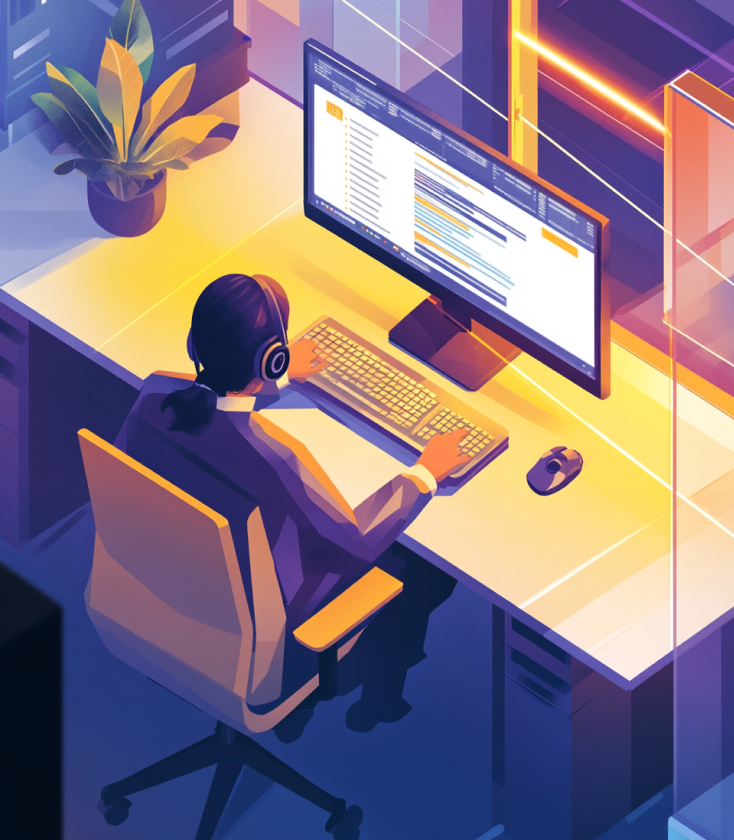Your Phone System Might Be a Lawsuit Waiting to Happen: The E911 Compliance Guide Nobody Wants to Read (But Everyone Needs To)
Picture this: An employee collapses in your office building. A coworker frantically dials 911. The dispatcher answers, but here’s the problem—your phone system only sends your company’s main billing address.
Not the floor.
Not the suite.
Just “123 Main Street” for a building that spans six floors and houses twelve different companies.
The ambulance arrives, but now they’re wandering the lobby asking which company called and where the emergency actually is.
Congratulations, your outdated phone system just turned a medical emergency into a game of hide-and-seek with paramedics. And if that employee doesn’t make it?
Well, let’s just say the lawyers are going to have a field day with your compliance failures.
Welcome to the world of Enhanced 911 (E911), where your business phone system is legally required to do more than just connect calls. It needs to tell emergency responders exactly where someone is calling from, down to the floor and room number.
If your system can’t do that, you’re not just behind the times—you’re actively breaking federal law. (And unlike your teenage years, “I didn’t know that was illegal” won’t fly here. The FCC doesn’t accept “oops” as a compliance strategy.)
What Even Is E911? (And Why Should You Care?)
Enhanced 911, mercifully shortened to E911, is the system that automatically transmits a caller’s location to emergency dispatchers when they dial 911.
Unlike traditional 911, which basically shrugged and said “good luck finding them,” E911 includes Automatic Location Information (ALI) that pinpoints where the call is coming from.
For landlines, this used to be straightforward—every phone number mapped directly to one address. Simple. Easy. The good old days. But then VoIP happened, and cloud phone systems happened, and suddenly people were making calls from their laptops at coffee shops, their phones at home, and their desk phones at the office—sometimes all in the same day.
Modern phone systems need to track all of this dynamically.
When someone dials 911 from a softphone while working remotely, the system needs to know they’re calling from their house in Portland, not the corporate office in Detroit.
When they call from a conference room on the third floor, emergency services need that specific location—not just the building address.
The technology behind this includes several components that sound like alphabet soup:
- ALI (Automatic Location Identification): The database mapping phone numbers to physical addresses
- ELIN (Emergency Location Identification Number): A temporary number identifying the caller’s location during emergencies
- PSAP (Public Safety Answering Point): The actual 911 call center staffed by dispatchers
- Dispatchable Location: The detailed information that gets responders to the right building, floor, and room
It’s almost adorable that we needed laws to mandate this. “Hey, maybe when someone’s dying, we should tell the ambulance exactly where they are?” Groundbreaking stuff.
The Laws You’re Probably Breaking (Or Will Be Soon)
Two major federal laws now govern E911 compliance, both born from tragedies that should never have happened in the first place.
Kari’s Law came about after nine-year-old Kari Hunt watched her mother get murdered in a hotel room. She tried calling 911 multiple times but couldn’t reach emergency services because the hotel phone system required dialing “9” first to get an outside line. A child knew to dial 911. The phone system was literally too stupid to let her.
Congress eventually decided that maybe—just maybe—people in crisis shouldn’t need to remember arbitrary prefixes to call for help.
Kari’s Law now mandates:
- Direct dialing of 911 from any phone extension without prefixes
- Automatic notification to on-site personnel (like security) when someone dials 911
The second law, RAY BAUM’s Act, goes further by requiring “dispatchable location” information. Not just the building address, but the specific floor, suite, or room number. Some companies thought “somewhere in this 500,000 square foot campus” was specific enough- it’s not.
RAY BAUM’s Act requires:
- Transmission of detailed location info to PSAPs regardless of device type
- Coverage for VoIP, mobile devices, and multi-line telephone systems (MLTS)
- Compliance for both on-premise and cloud-based systems
The Federal Communications Commission doesn’t mess around with enforcement, either. Violations can cost up to $10,000 per incident, plus daily penalties until you fix the problem. That’s before we get into the civil liability if someone actually gets hurt because your system couldn’t tell paramedics where to go.
There are also two levels of compliance that businesses must meet:
- Phase I Compliance: requires your phone system to provide the PSAP with the caller’s phone number and general location.
- Phase II Compliance: demands precise location information—specific floor, suite, or room number—so responders can find the caller without wandering around asking which office called 911.
The truly special part? These laws exist because companies consistently chose not to implement these features on their own.
It literally took federal legislation to get businesses to prioritize “helping people not die” over saving a few bucks on their phone systems.
Why Your Business Actually Needs This (Yes, Even Yours)
Every business owner thinks they’re special. “We’re too small for this to matter.” “Our employees are all in one building.” “Nothing bad ever happens here.” Right. And the Titanic was unsinkable.
Physical Locations:
Retail stores, restaurants, healthcare facilities, schools—any business with foot traffic needs reliable E911. When a customer has a heart attack in your store or a student gets injured on campus, seconds matter.
E911 systems can cut emergency response times by nearly a minute according to industry reports. In a cardiac emergency, that minute is literally the difference between life and death.
Hospitals and medical facilities face an even higher bar. If you’re in the business of saving lives, having a phone system that can’t accurately direct emergency services to the right floor is beyond ironic—it’s potentially catastrophic.
Fire emergencies, active shooter situations, medical crises—they all require precise location data immediately.
Remote and Mobile Workers:
The work-from-home revolution created a compliance nightmare. Your employee could be taking calls from their home office on Monday, a coffee shop on Tuesday, and a co-working space on Wednesday. If they dial 911, does your system know where they actually are? The FCC’s VoIP 911 Guidelines make it clear that your system must know.
Hybrid Workforce:
Perhaps the trickiest scenario. Employees splitting time between office and home need E911 information that updates automatically based on where they’re actually working. That softphone app they use? It needs to know whether they’re at their desk on the third floor or at their kitchen table in the suburbs.
The “it won’t happen to me” mentality crumbles fast when you look at the statistics.
Buildings catch fire. People have medical emergencies. Accidents happen. And when they do, having a compliant E911 system isn’t just good business practice—it’s the difference between a scary story everyone survives and a tragedy that ends careers.
Multi-location businesses face additional headaches. Retail chains with dozens of stores, companies with branch offices across multiple states, universities with sprawling campuses—they all need E911 systems that can accurately identify which location an emergency call is coming from. “Which of our forty-seven stores is on fire?” is not a question you want dispatchers asking.
The Bottom Line: Compliance Isn’t Optional, and Ignorance Isn’t a Defense
The legal exposure alone should terrify any business owner. Beyond FCC fines, there’s civil liability to consider. If someone dies or gets seriously injured because your phone system couldn’t tell paramedics where to go, you’re looking at wrongful death lawsuits, insurance claim denials, and the kind of media coverage that permanently destroys reputations.
“Local Company’s Outdated Phone System Blamed for Death” is not a headline any PR team can spin.
State regulations can pile on additional requirements beyond federal law, so you might be non-compliant in multiple ways simultaneously. Fun!
Administrative headaches multiply too. E911 isn’t “set it and forget it.” Addresses need updating when employees move. Location data requires verification when people change offices or work remotely.
Someone in your organization needs to own this, which means training, documentation, and ongoing maintenance.
Ignoring E911 compliance is essentially gambling that nothing bad will ever happen on your watch. Bold strategy. Terrible odds.
How Techmode Solves Your E911 Compliance Nightmare
This is where Techmode’s UCaaS platform actually shines. Unlike competitors running shared, multi-tenant systems, Techmode deploys each client on dedicated AWS instances with complete E911 management built in.
The system automatically tracks endpoints, manages ALI data, and ensures accurate location transmission across desk phones, softphones, and mobile devices.
Multi-location businesses get centralized E911 management across all sites, with dynamic location updates as users move between offices.
Remote workers’ location data updates automatically based on their network connection. The system even sends automatic notifications to internal security teams when 911 is dialed.
Best part? Techmode’s concierge support team—actual U.S.-based humans who answer the phone—helps configure and maintain your E911 compliance. No offshore call centers, no ticket queues, no “have you tried turning it off and on again” nonsense. Just white-glove service ensuring your system works when lives depend on it.
Configuration happens during onboarding, with ongoing support for address updates, location verification, and compliance audits. Techmode handles the technical complexity while keeping you compliant with federal and state regulations.
For organizations still running legacy systems, our guide on migrating from on-prem PBX to cloud breaks down where UCaaS and CCaaS fit in—and how to upgrade safely.
E911 FAQ: The Questions You’re Probably Googling Right Now
Q: Do small businesses really need E911 compliance?
A: Yes, unless you enjoy FCC fines and potential lawsuits. Federal law applies to any business using multi-line telephone systems or VoIP, regardless of size. “We’re too small” is not a legal defense. (FCC Guidance)
Q: How often should we update our E911 location information?
A: Whenever addresses change—which means during employee onboarding, office moves, or when remote workers relocate. Best practice is reviewing location data quarterly and making updates mandatory for any address changes.
Q: What happens if we’re non-compliant and someone dials 911?
A: Best case: confusion and delays while dispatchers try to figure out where to send help. Worst case: someone dies, you face wrongful death suits, FCC penalties up to $10,000 per violation plus daily fines, and insurance denies your claims.
Q: Can E911 work with our existing phone system?
A: Modern cloud communications platforms integrate E911 capabilities directly. Older on-premise systems may require upgrades or replacement. If your system can’t provide dispatchable location information, it’s not compliant—full stop.
Q: What’s the difference between E911 for landlines versus VoIP/mobile devices?
A: Landlines use fixed addresses tied to phone numbers. VoIP and mobile devices require dynamic location tracking via GPS, cell tower triangulation, or network-based identification. VoIP systems must update location data automatically as devices move between networks.
For more UCaaS and CCaaS insights, visit the Techmode Blog.










